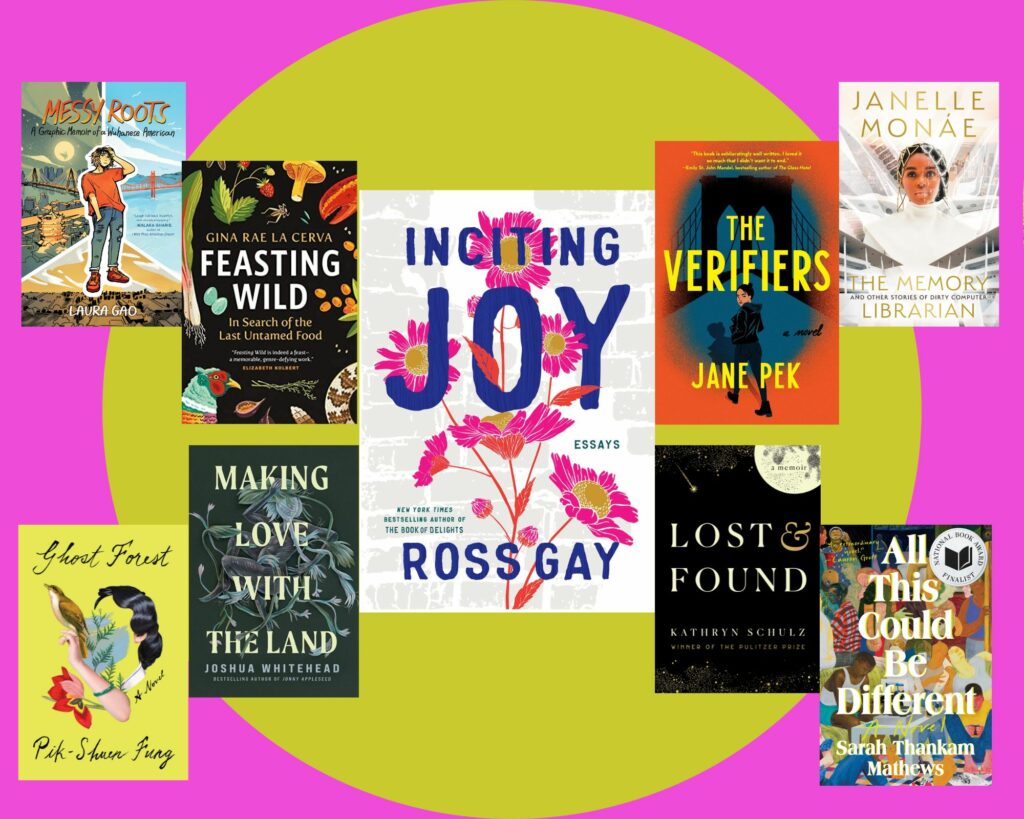
Wishing everyone in our community a peaceful New Year—and stacks of books to enjoy on long winter nights. This December we share our Top 2 in 2022 Staff Picks from the library. Read on for elves, adventures, audiobooks, local authors, and more! Hope to see you at the library soon.
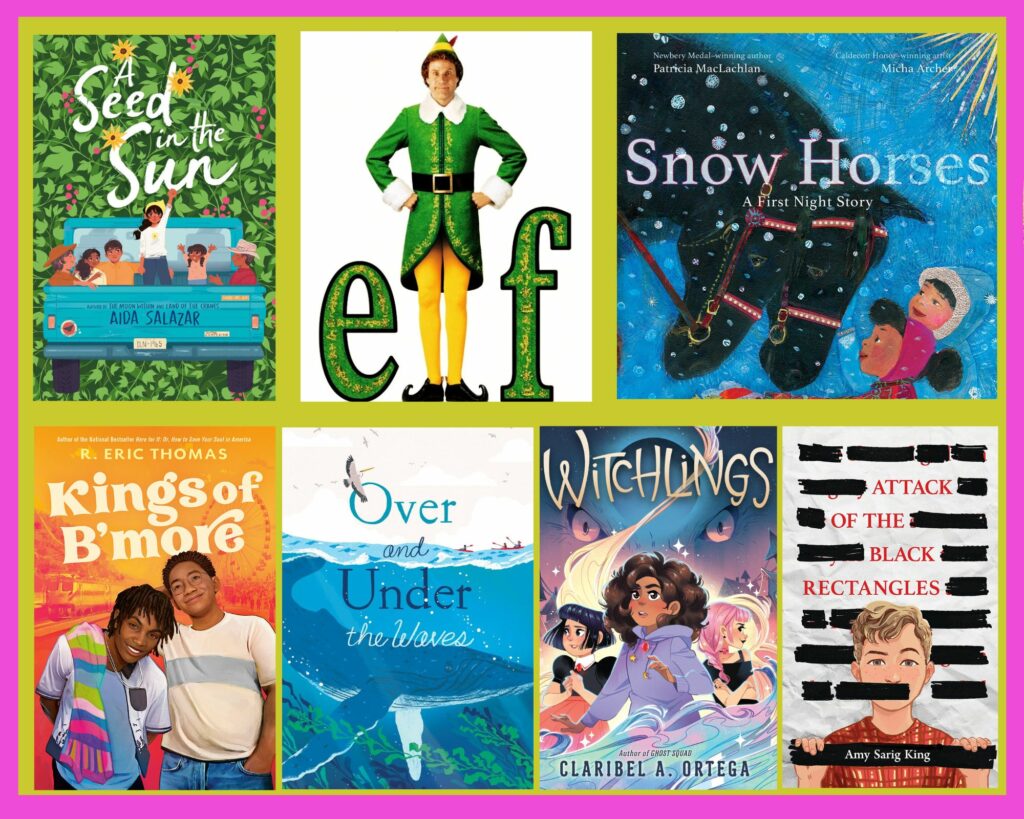
Cindy’s (Top 2 Holiday!) Picks
One of my absolute favorite holiday movies is Elf, with Will Ferrell. IMDB describes it best: “Raised as an oversized elf, Buddy travels from the North Pole to New York City to meet his biological father, Walter Hobbs, who doesn’t know he exists and is in desperate need of some Christmas spirit.”
It’s a wonderful feel-good, laugh fest that ticks off all the emotion boxes AND delivers some great lines such as, “We elves try to stick to the four main food groups: candy, candy canes, candy corns, and syrup,” “I’m a cotton-headed Ninnymuggins!” and “The best way to spread Christmas cheer is singing loud for all to hear.” Put this holiday gem on hold today!
Another great holiday title is an old family favorite since 1983 when this movie came out: A Christmas Story with Peter Billingsley as the main character. “In the 1940s, a young boy named Ralphie Parker attempts to convince his parents, teacher, and Santa Claus that a Red Ryder Range 200 Shot BB gun really is the perfect Christmas gift.” A couple of great quotes from this touching but hilariously funny movie are: “I can’t put my arms down!” and “I triple dog dare ya!” Ralphie and his little brother will leave you pining for the days of yore.
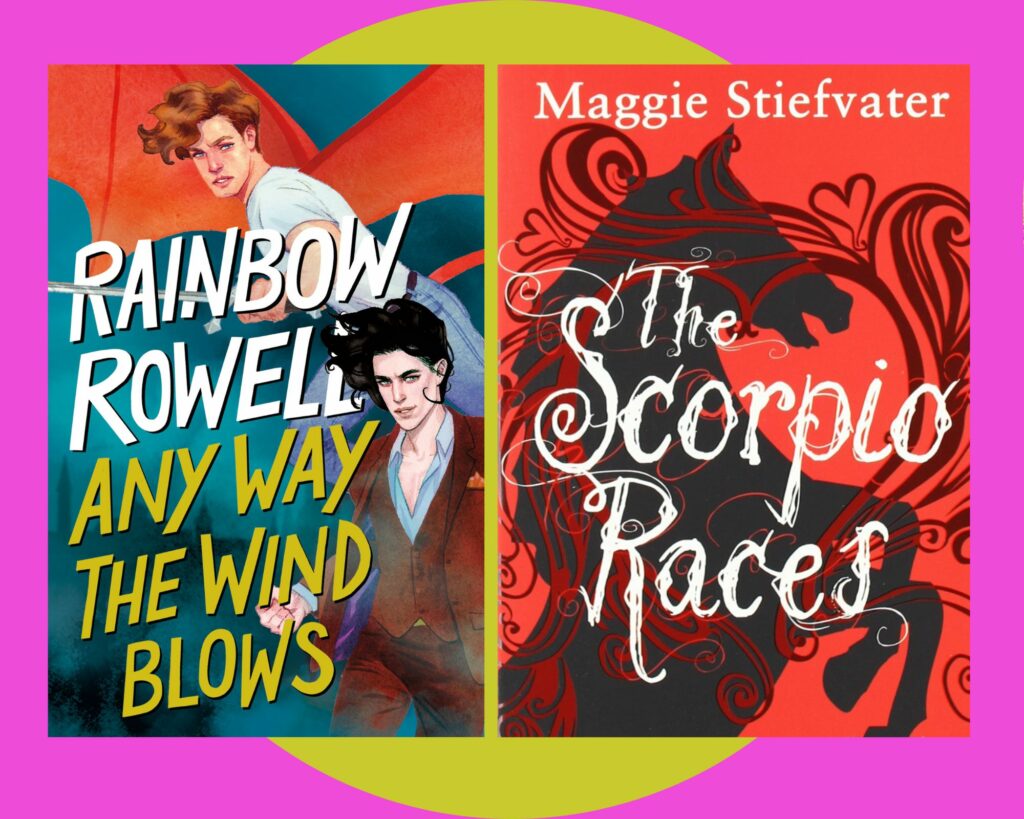
Julia’s Picks
I spent much of this year diving into PPL’s incredible Teen and Children’s collections as well as CloudLibrary, so it’s no surprise that my two favorite finds of 2022 were both YA audiobooks (though they are available in print form as well).
Before reading the Simon Snow trilogy by Rainbow Rowell, I would have said I wasn’t into romance, especially when it involved vampires. I was gloriously wrong. This is a clever, funny, emotional series that upends fantasy tropes left and right. The final book, Any Way the Wind Blows, tore my heart out with its depiction of what comes after “happily ever after.” But definitely start with Book 1, Carry On! The audiobooks, narrated by Euan Morton, are top notch.
The Scorpio Races, by Maggie Stiefvater, is an atmospheric, character-driven fantasy rooted in Celtic legend. Each November on the small island of Thisby, riders race the island’s famous horses along the shore. But these are no ordinary horses! They are capaill uisce: fierce, carnivorous water horses that lure their riders into the sea. The story centers on reigning race champion Sean Kendrick and fiery, determined Puck Connolly, two young islanders with their own reasons for needing to win. Stiefvater’s subtly lovely prose captures both the magic and the hardship of island life. Perfect listening for a chilly day, with a cup of tea and a pile of blankets.
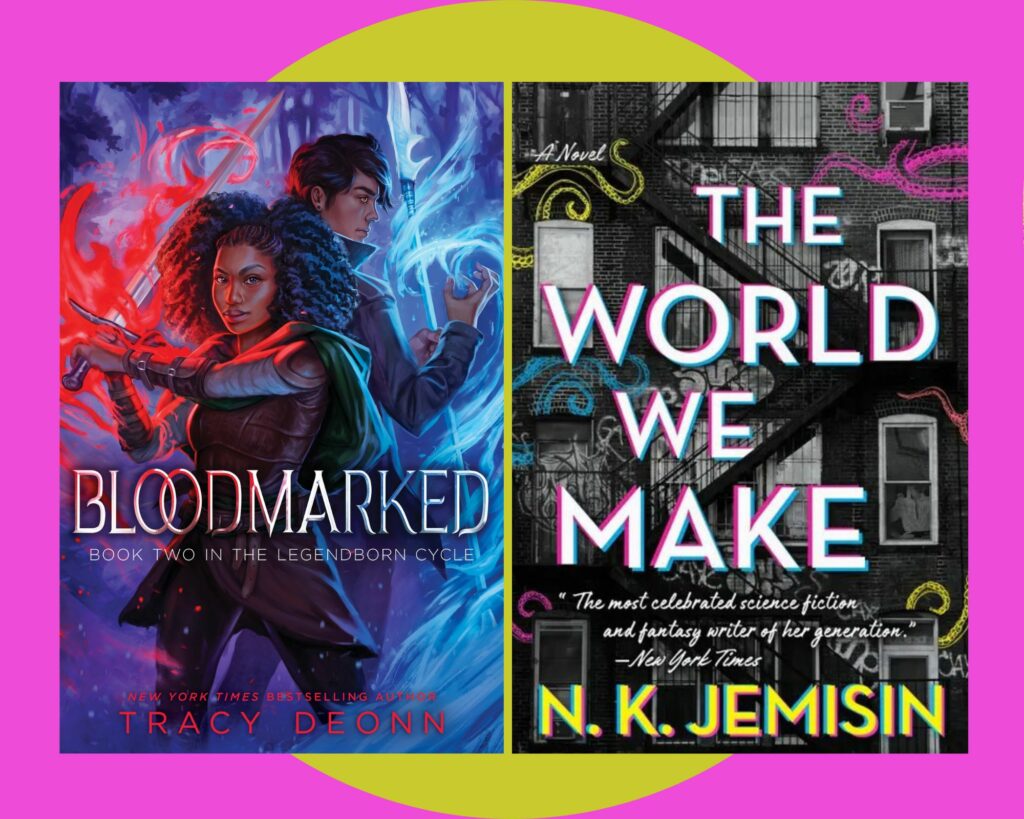
Emily’s Picks
Two of my most anticipated books of the year came out in November, and I was completely absorbed in the breathtaking storytelling found in each.
Bloodmarked is Tracy Deonn’s captivating sequel to Legendborn, which follows the story of a grieving girl who grows into incredible powers, steeped in Arthurian legends, set at UNC Chapel Hill. The magic and action are intense, the character and world building are impressive, and I can’t wait to see what happens next for Bree! (And how the love triangle is resolved!)
The World We Make is another excellent book from N.K. Jemisin, and it’s best heard as an audiobook — Robin Miles narrates this and its previous chapter, The City We Became, with her whole heart, plus a slew of accents and characterizations. Sound and voice effects complete the creepy atmosphere as aliens come to Earth to change New York City as we know it.
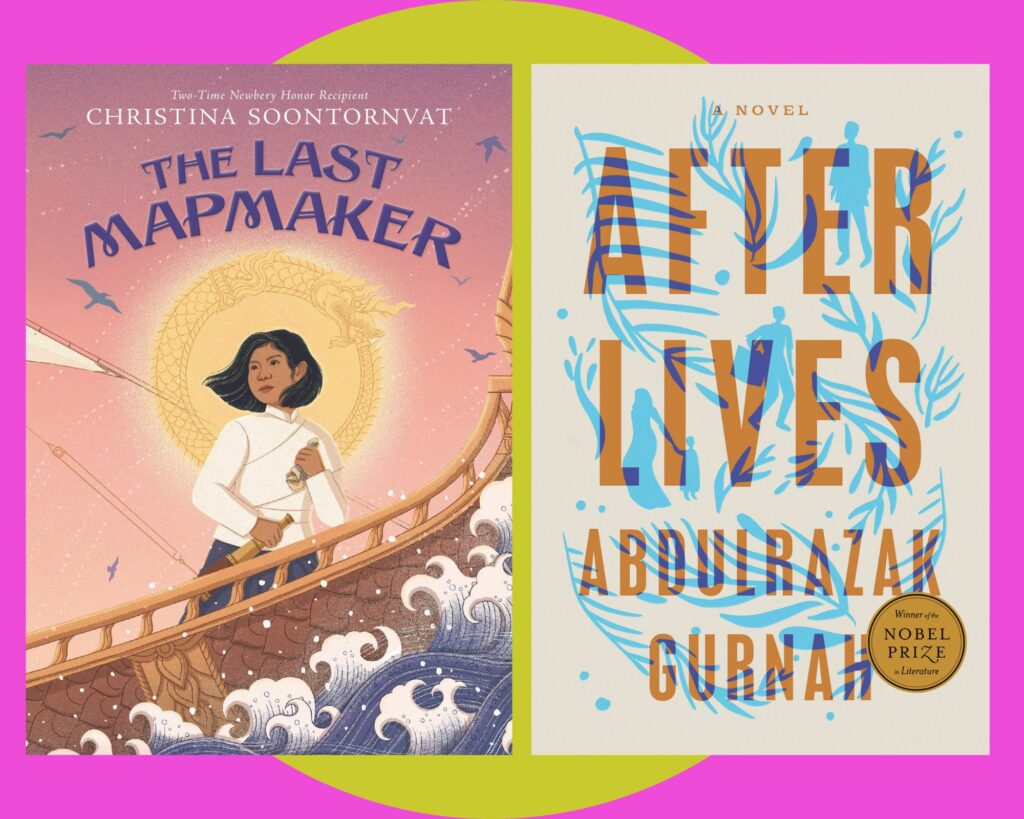
Vicky’s Picks
My two top books of the year? It’s an agonizing assignment, and the titles I consider change from day to day. Commit I must, so here’s two.
This past spring, Newbery honoree and Sibert winner Christina Soontornvat brought us The Last Mapmaker, a middle-grade adventure set in a Thai-inspired fantasy world. Sai is lowborn, but she pretends to be upper-class in order to secure a position as apprentice to Mangkon’s Master Mapmaker. The clock is ticking on her deception, so when her master is tapped to join an expedition to the unexplored Sunderlands, she sees in it her opportunity to strike out and establish herself. The voyage raises penetrating questions into colonialism and the problematic nature of exploration and discovery. That Soontornvat weaves these difficult questions into a 100-percent satisfying rip-roaring maritime adventure establishes her as a master in her own right.
And for adults, Nobel Laureate Abdulrazak Gurnah reaches back into Tanzanian history to offer up Afterlives, a generational saga set in what begins as Deutsch-Ostafrika, becomes a British protectorate after World War I, and eventually achieves independence as Tanzania by the end of the book. Sweeping though the historical setting may be, the novel holds at its heart its characters: Khalifa, the merchant’s rascally bookkeeper; Asha, his angrily devout wife; Afiya, their ward who comes to them as a child; and Hamza, the young man who joins the German Schutztruppe and finds refuge with Afiya after. Their lives are all touched in some degree by colonialism and its brutalities, but they nevertheless live on, and Gurnah’s careful, loving exploration of each fully three-dimensional character folds readers in. I listened to the audio edition, and Damian Lynch’s narration is as loving as Gurnah’s writing.
Ask me on another day, and I might mention two different titles. But these have stayed with me for months as two of my favorite reads of 2022.
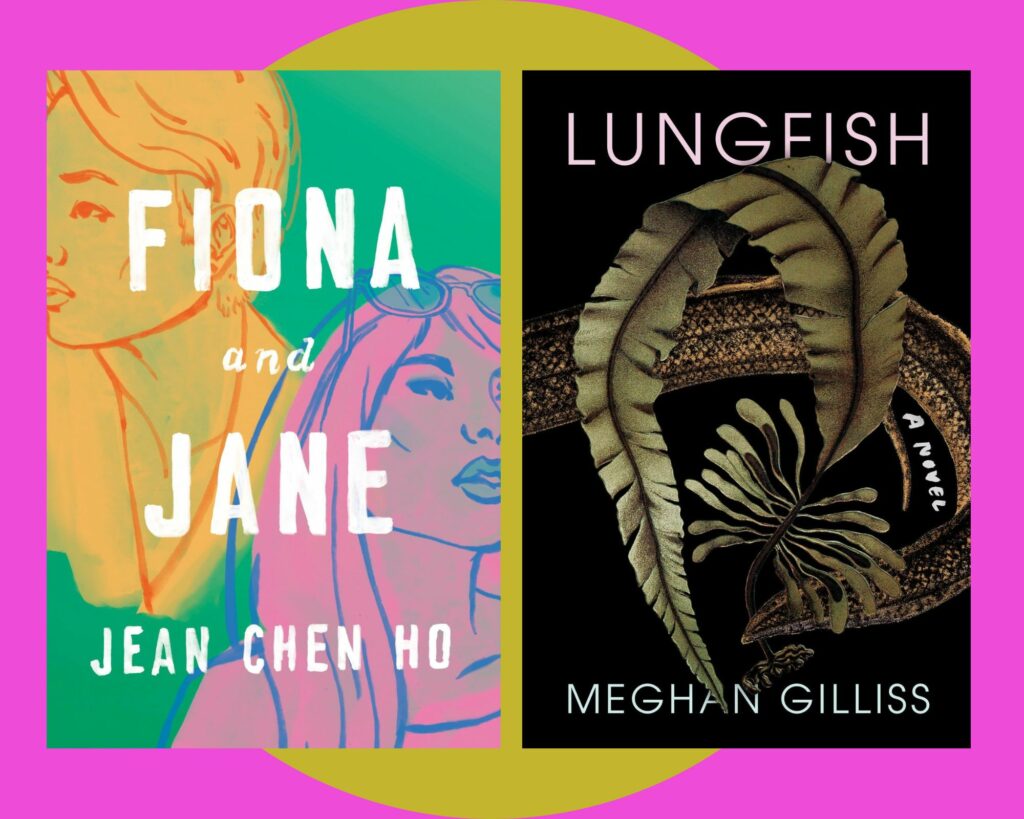
Becca’s Picks
2022 was filled with amazing books. My favorite 2022 release is Babel, by R.F. Kuang. Since I’ve already sung its praises in another Staff Picks post, I figured I would highlight my second-favorite books published this year:
Fiona and Jane (Jean Chen Ho) follows the trajectories of best friends as they graduate from college and become geographically separated. Told in alternating narrations, the book follows Fiona and Jane as individuals, navigating the tragedy and beauty in their separate lives and the ebb and flow of their friendship. I loved this meditation on friendship, love, and loneliness; it’s been a while since a book has made me cry, but this one did the trick!
I love books where a story folds in on itself, where every chapter provides a new glimpse of our characters’ internal lives. In Lungfish (Meghan Gilliss), we receive glimpses of the present and past of Tuck, a woman who is trying to support her husband (who is detoxing from opioids) and young daughter while isolated on a coastal Maine island with no money and no food. This book is visceral; while reading, I found myself eating constantly, as if to send the food through the pages and into the bellies of Tuck and her family. I also read this book in record time, voraciously hoping they were able to leave the island before winter descends. Don’t miss out on this gem by a great local author!

Janice’s Picks
In The Swimmers, award-winning author Julia Otsuka has written a novel exploring both ordinary and extraordinary dimensions of daily life. The pool is routine, refuge and subculture. “Up above there are wildfires, smog alerts, epic droughts, paper jams, teachers’ strikes, insurrections, revolutions, blisteringly hot days that never seem to let up (Massive “Heat Dome” Permanently Stalled over Entire West Coast), but down below, at the pool, it is always a comfortable eighty-one degrees.” Regular lap swimmers might easily recognize themselves somewhere in Otsuka’s descriptions of rigid pool routines, such as rigorously counting laps, marking swim time to the minute, unvarying arrival times, and stubbornly choosing the same lane. When the pool develops a mysterious crack, the novel invokes the challenges of dementia, the coronavirus pandemic, and the general unpredictability of our lives.
The Wall, a 1968 international bestseller by Austrian writer Marlen Haushofer (translated by Shaun Whiteside)—a book variously described as dystopian, utopian, feminist, and science fiction—has been recently reissued in English by New Directions. The narrator is a middle-aged woman vacationing in the Austrian mountains, who suddenly finds herself cut off from civilization (which seems to have been destroyed) by an invisible wall. Both compelling and haunting, the narrator recounts her challenges to sustain daily existence. “But I would rather turn to the second of July, the day I realized my life depended on the number of matches I had left. That thought struck me, as all disagreeable thoughts do, in the early hours of the morning.” The Wall was adapted into a 2013 film, available on DVD at PPL.
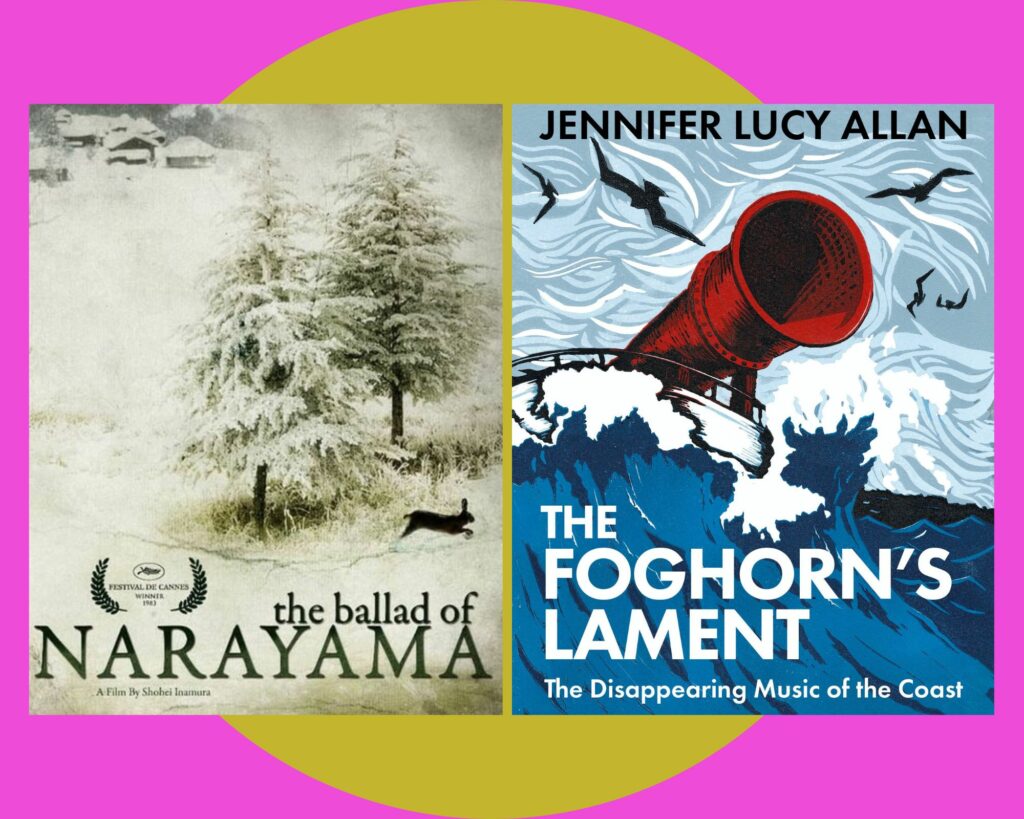
Aaron’s Picks
Right around the beginning of the year, I watched the stunning Ballad of Narayama (Keisuke Kinoshita, 1958) on a cold night in the snow-covered White Mountains. The film, based on a 1956 novella by Shichirō Fukazawa, tells a tale based on the mythical practice of ubasute, in which elder members of a community, after reaching a certain age, are transported to a mountain top and left to their deaths. The practice, as presented in the film, is a measure used to ensure enough resources are available for the younger members of a family. Predictably, some elders are more resigned to their fate than others, and some of those left behind are more willing to leave their beloved parents to their fates than others. The drama crosses three generations of the family at the center of the film and extends to their entire village. That village, in addition to the snowy mountaintop destination of the elders and nearly every other setting (along with weather of all kinds, water features, etc.), was ingeniously created and stunningly filmed on a soundstage, rather than in more realistic settings (not the case for a more naturalistic 1983 remake). Though the production is heavily influenced by Kabuki theater, the cinematography is more dynamic than a usual filmed stage production, and the limitations of the soundstage add to the mythical and magical feeling of the film, rather than detracting from it.
As the year draws to a close, I am enjoying Jennifer Lucy Allan’s The Foghorn’s Lament, based on the author’s years of research on the history, culture, and meaning surrounding the signature sound of our foggy coastlines, after a long wait. Allan searches in archives, spends a month almost entirely alone at a lighthouse in the Shetland Islands, and plumbs the depths of her personal cultural references to tell the fascinating story. I first became aware of the research that would become this eagerly-awaited-by-me book when I shared a session with the author at a conference on sound art held in the Azores, the Portuguese-held archipelago in the middle of the North Atlantic, in 2017. The day following our paper presentations, the stakes for the successful operation of foghorns and other navigational aids was made clear in a keynote lecture by celebrated composer and sound artist Hildegard Westerkamp. In what was clearly a planned but nonetheless incredibly difficult interlude in her presentation, Westerkamp emotionally explained the personal significance of the conference’s location — in 1957 her beloved older brother, who had been a sailor, was lost at sea when the tall-ship Pamir sank in a hurricane just west of the Azores. That ship didn’t run aground where a foghorn might have saved it, but trouble with radio transmissions and other then-current technology contributed to its sinking. Allan’s paper, Westerkamp’s lecture, and now The Foghorn’s Lament are all linked for me now, to a past and present we can see and hear as close to home as Portland Head Light, where a foghorn still stands and where the Annie C. Maguire was lost against the rocks in 1886.

Fionna’s Picks
I loved The Man Who Could Move Clouds, a memoir by Ingrid Rojas Contreras—one of my October Staff Picks.
Another favorite book that I read in 2022 was a 2019 collection of stories titled Salt Slow by Julia Armfield. I found myself looking through Armfield’s back list after being enchanted with her debut novel (Our Wives Under the Sea) which came out this year. Salt Slow was odd and beautiful and the titular story could very well become a dystopian folk tale for the next generation.
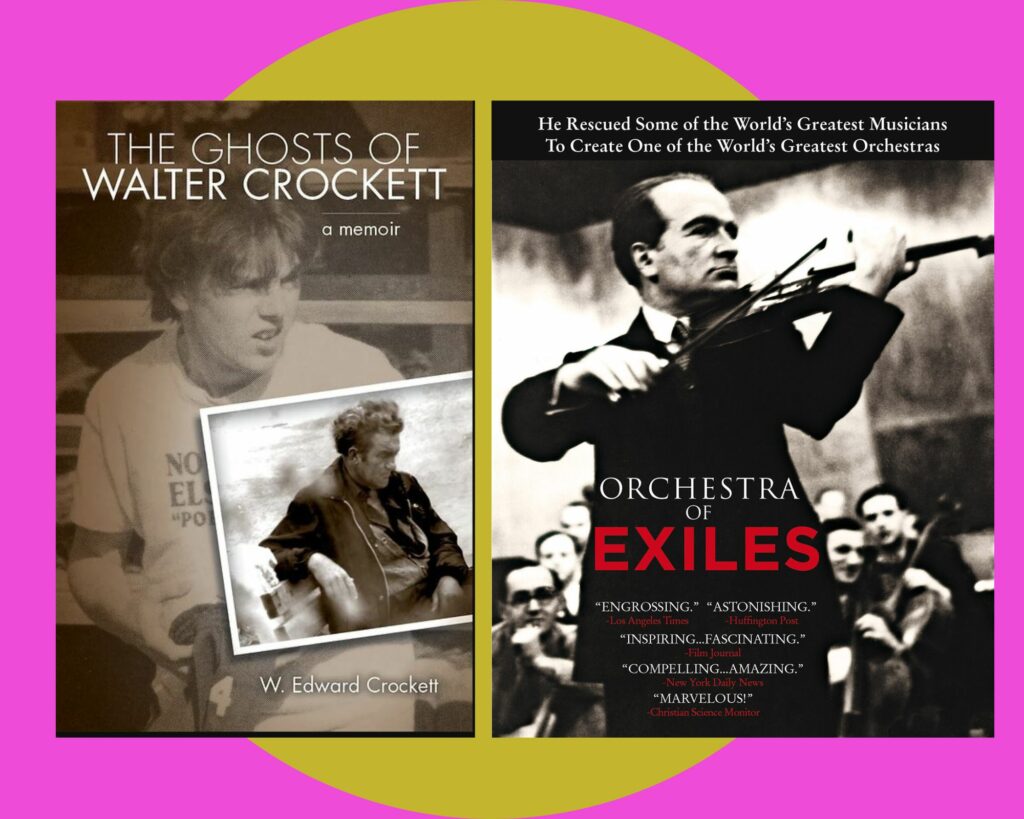
Nina’s Picks
Combining my love of local history and memoir, The Ghosts of Walter Crockett is a bittersweet story of growing up in the 1960s-1970s on Munjoy Hill. Told by Walter’s son, Ed Crockett, the book focuses on life with seven siblings, a mother who tried her hardest to cope (with varying degrees of success), and a father who abandoned his wife and young children to live on Portland’s gritty streets. Ed paints a depressing yet ultimately hopeful picture of life on “The Hill” and his struggle to come to terms with its challenges.
October 2022 brought the Violins of Hope exhibit to Portland, an extraordinary collection of string instruments that were owned by Jewish musicians during the Holocaust. These instruments were displayed at the Maine Jewish Museum and played by musicians of the Portland Symphony during performances of the Verdi Requiem. Orchestra of Exiles is a DVD chronicling violinist Bronisław Huberman’s successful attempt to relocate Jewish European musicians at a time when Hitler was coming to power. Over four years, Huberman helped save nearly 1000 people and created what became the Israel Philharmonic—one of the world’s greatest orchestras.
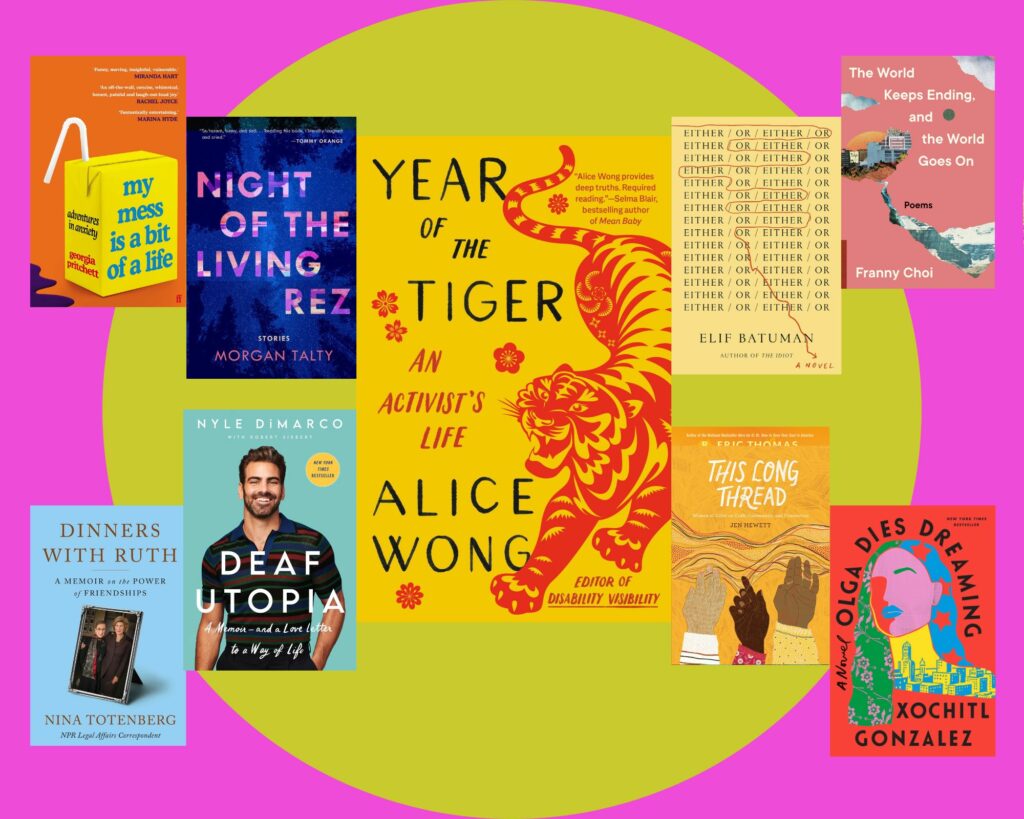
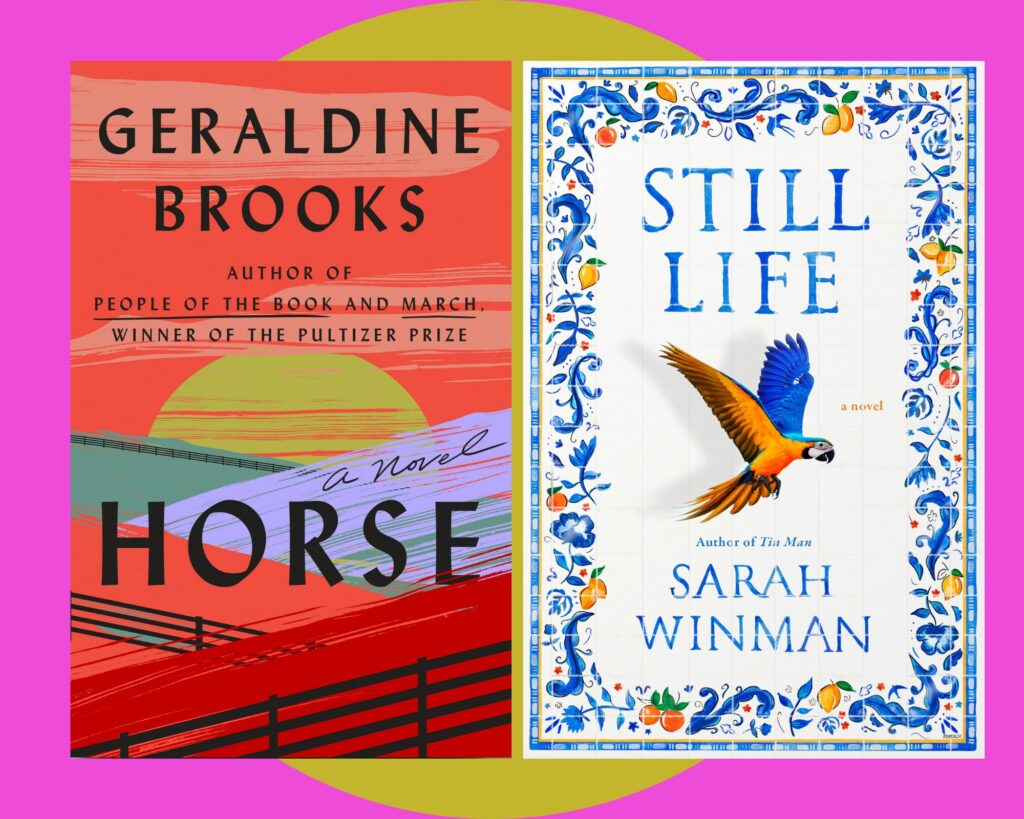
Stephanie’s Picks
Top Two: Horse by Geraldine Brooks; Still Life by Sarah Winman.
Other big faves: Painted Horses by Malcolm Brooks (hmm: 2 Horse titles and 2 Brooks authors); Small Things Like These by Claire Keegan; Vigil Harbor by Julia Glass; These Precious Days by Ann Patchett.
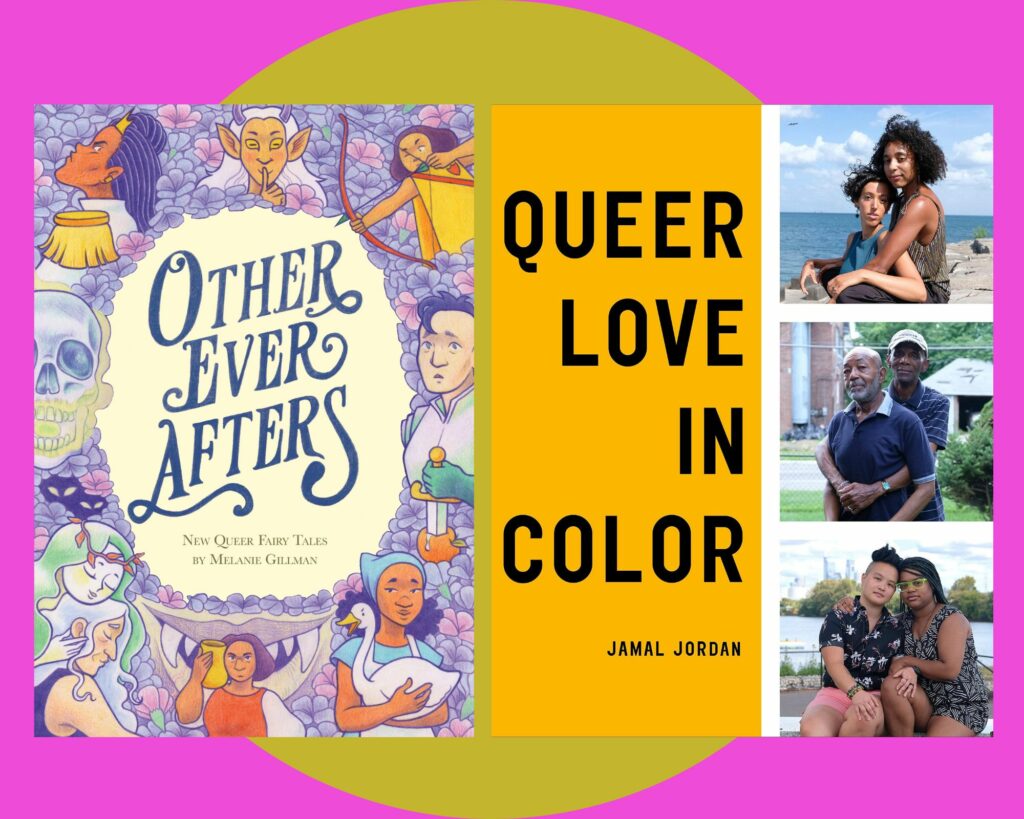
Elizabeth’s Picks
At the year’s end I’ve returned to two books that brought me joy in 2022. Illustrator and writer Melanie Gilman’s Other Ever Afters is a graphic novel of new queer fairy tales. Playful, compassionate, and subversive, Other Ever Afters says Let’s reimagine old stories!—let’s not get stuck there!—let’s write completely new ones! Their new fairy tales explore friendship, community, purpose, and change along with the adventures of mermaids, giants, and knights. (For additional joyous, complex queer fairy tales—of foxes, robots, and dragons—see last year’s wonderful The Fox’s Tower and Other Tales by Yoon Ha Lee). To all who write new queer stories: thank you.
Jamal Jordan’s photo documentary project Queer Love in Color is a further celebration of queer love, here in this world, in these times, and that’s worth celebrating every day. Dozens of stories and portraits of joy, support, and togetherness fill the book. When Tzu-Yung talks about falling for Briyana, they say, “I started to allow myself to be silly and fun and airy like I am now.” Lady Phyll writes, “In each other’s arms we create a world of possibilities, tenderness, and empowerment.” And Jamal Jordan muses, “Perhaps the most transformative thing we can do is take the love that we have for others and turn it inward, towards ourselves.”
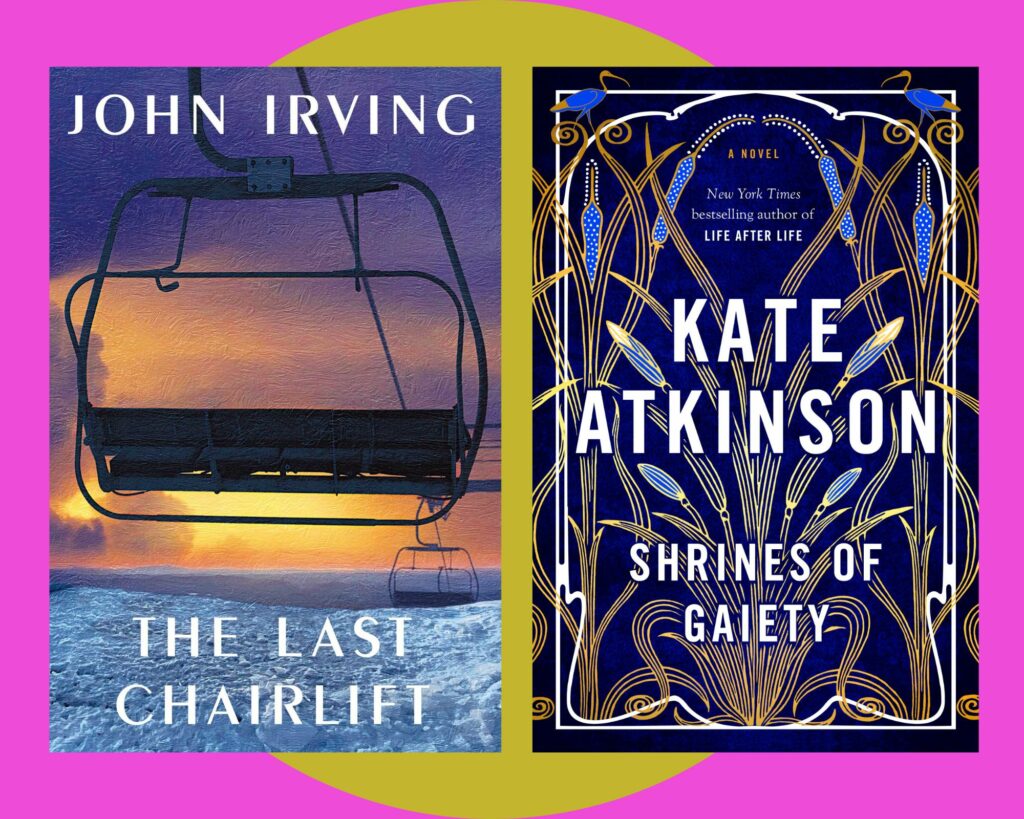
Eileen’s Picks
What glorious anticipation it is, watching my name slide toward the top of hold lists!
Kate Atkinson and John Irving are two of my very favorite authors, so imagine my delight to have read a 2022 release by each of them in the past month.
The Last Chairlift is classic John Irving from start to finish. From the familiar environs of the author’s native Exeter, New Hampshire to incomparably quirky characters, not to mention personal obsessions and social issues, I knew I was in for a seriously satisfying literary ride. At 80 years old, John Irving says this is his last long novel. Certainly, at 889 pages it is long, but finally and foremost it is immensely satisfying in all Irving’s usual ways. Comparisons and references to Charles Dickens abound when John Irving is up for discussion; that seems right to me. I think “The Washington Post Book World” quote sums up his storytelling: “Irving’s characters can beguile us onto thin ice and persuade us to dance there. His instinctive mark is the moral choice stripped bare, and his aim is impressive.”
Kate Atkinson’s new novel, Shrines of Gaiety, made my wait for The Last Chairlift not only tolerable but experientially short-and-sweet. Good grief, what a mind and what a writer! I know I said that Irving’s characters are incomparably quirky…and I absolutely meant it…but Atkinson gives him some serious competition, with a Great British twist.
Really, honestly, seriously: if you cannot get your hands on The Last Chairlift or Shrines of Gaiety right this minute, picking up anything written by either of them will get you through the wait.
Both Atkinson and Irving tell stories that are addictive and deep, spoken in voices that matter. For sheer entertainment they are hard to beat, but they deliver so much more.
May 2023 bring us shorter books by John Irving, any books by Kate Atkinson, joy, peace, and hearts so full we cannot contain them!
As ever, thanks for reading! To find all the Top Two in 2022 Staff Picks discussed and pictured here, explore The World We Make: December Staff Picks.
If you’re looking for more reading ideas, that is our very favorite thing! Check out our Your Next Great Read service for readers of all ages, or simply reach out to our staff at readersadvisory@portlib.org for your own personalized booklist of reading suggestions.
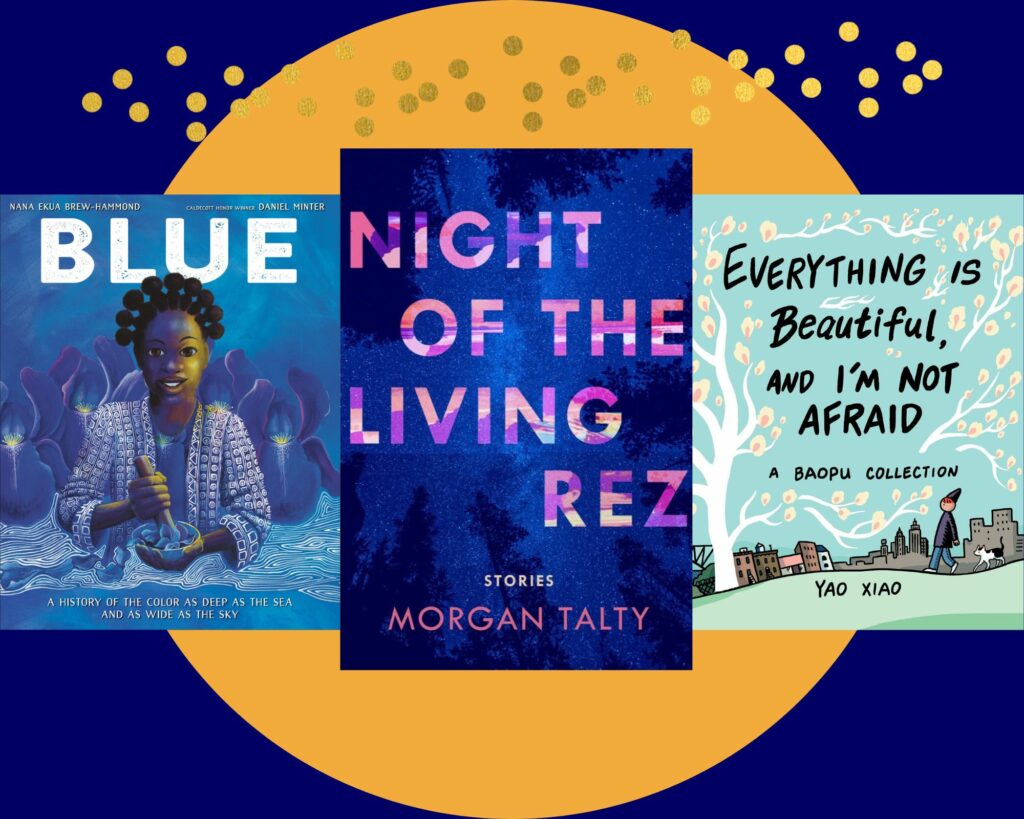
Snow has fallen in Maine, and we’re all tilting further from the sun, but no fear: the library is here for you. We have plenty of wonderful new books, audiobooks, eBooks, movies and more to brighten short days and long nights.
Have you seen Daniel Minter’s illustration exhibit in the Lewis Gallery? If you borrow the new picture book Blue: A History of the Color as Deep as the Sea and as Wide as the Sky, you can find his beautiful illustrations of Nana Ekua Brew-Hammond’s story of blue, too.
Looking for a great graphic novel? Try Una’s staff pick, Everything is Beautiful and I’m Not Afraid.
Have a big pumpkin pile that you need to put a dent in? You can find a herring-and-pumpkin (!) pot pie recipe inspired by Kiki’s Delivery Service in Studio Ghibli: The Unofficial Cookbook.
Excited about Morgan Talty getting shortlisted for the 2023 Andrew Carnegie Medal for Excellence in Fiction? Get on the list for Night of the Living Rez here.
Read on for our staff picks! We talk about new books from Indigenous authors as well as new poetry, the brilliant lives of octopuses, journaling in the great outdoors, the legacy of a famous cartoonist, the joys of black-and-white movies, and more.
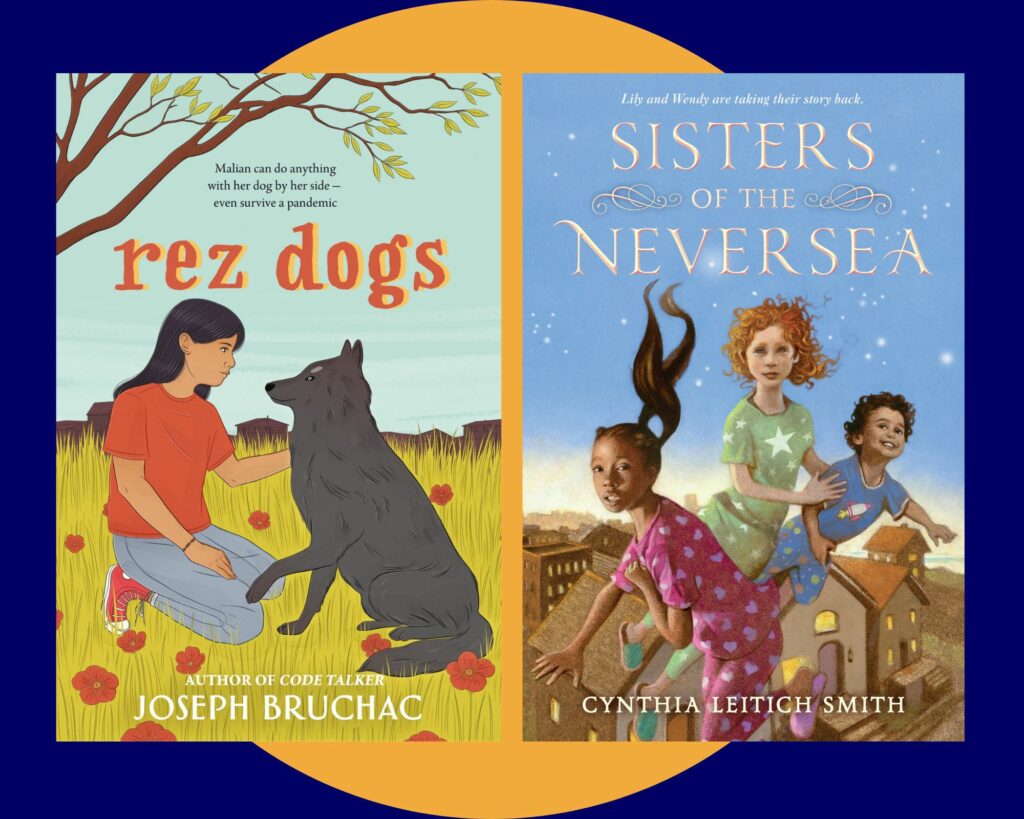
Vicky’s Picks
November is Native American Heritage Month, so it seems like an apt time to highlight a couple great recent middle-grade books by Native authors.
Rez Dogs, by Abenaki storyteller and author Joseph Bruchac, is a free-verse gem that takes readers to the Penacook reservation in spring of 2020, when Boston schoolgirl Malian’s visit with her grandparents is unexpectedly lengthened by the Covid-19 lockdown. There she struggles with remote school due to unreliable WiFi but deepens her understanding of her family and Native heritage through her grandparents’ stories. It’s a tender vehicle for harsh truths, and readers will emerge, like Malian, with a profound appreciation for her culture.
Switching from realism to fantasy, Sisters of the Neversea is a joyful revision of Peter Pan by Cynthia Leitich Smith, a Muskogee Creek author who grew up loving the J.M. Barrie classic though she winced at the portrayal of Neverland’s Indians. Lily and Wendy are stepsisters, Lily’s Creek mother having married Wendy’s white English father. As career tensions threaten their parents’ marriage, the girls find themselves separately taken to Neverland, where adventures aplenty ensue. Thanks to the ubiquity of the Peter Pan story, children don’t need to have read the original Barrie to see how Smith plays with its plot and characters to deliver a heartfelt tale that honors the cozy thrills of its inspiration while giving its diverse cast of characters the respect they deserve.
Read and share them now or anytime during the year—they’re both thoroughgoing delights, whatever the month.
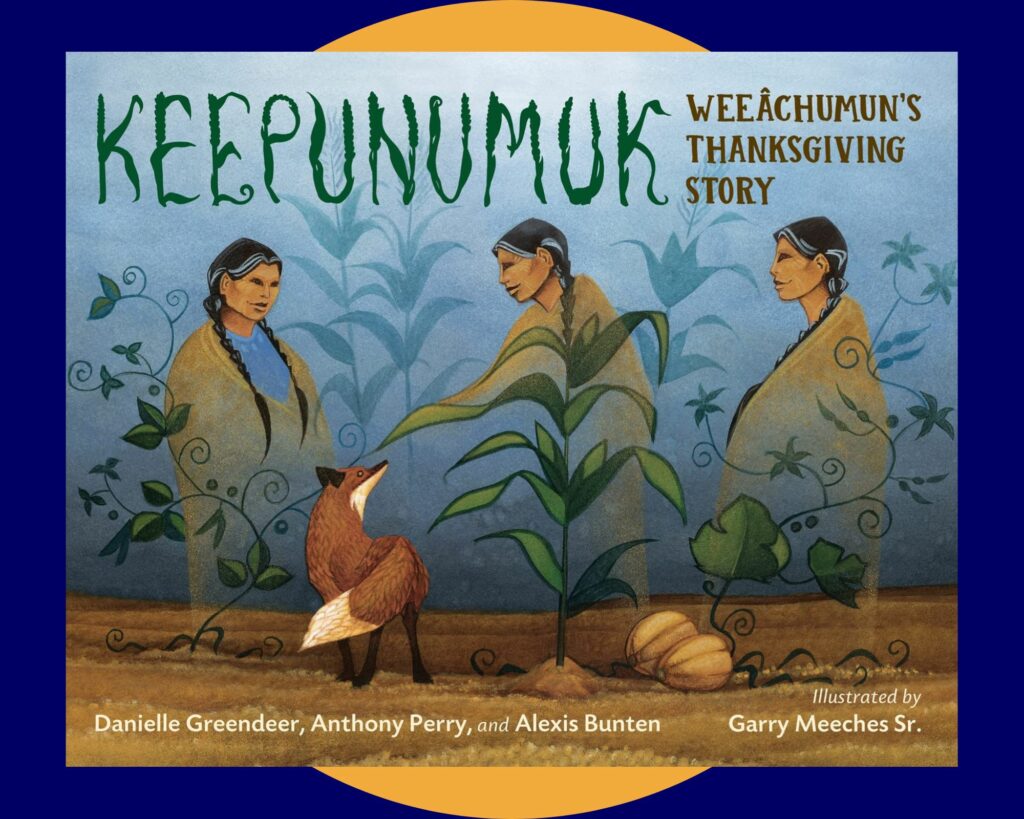
Emily’s Picks
Our family has recently enjoyed two picture books: one an excellent nonfiction book that explores what it would have been like to live during the Plimoth Thanksgiving. Meanwhile Keepunumuk discusses the same topic through a very different lens, with a Wampanoag grandmother explaining to her grandchildren how Weeâchumun (corn) and her sisters Beans and Squash saved the newcomers in their first years.
I have just devoured the third book in the Misewa Saga, The Stone Child. This middle grade series is written by David Robertson (Norway House Cree Nation) and began with the captivating book The Barren Grounds. Morgan and Eli are two Cree children who have been taken from their families and are living in the same foster home in Winnipeg. They both feel angry, disconnected, and annoyed about their earnest foster parents’ attempts to connect. Then the two discover a portal into another world in their attic—a world called Askí, where they meet giant talking animals and learn of the dangers they face in a land where it is perpetually winter. It’s a brilliant series that blends fantasy adventures and reality. Morgan and Eli learn and share traditional Cree words and ways to survive, growing closer over the years they spend in another realm. Highly recommended reading as we head into a snowy winter world of our own!
Now I’m excited to dive into another story, Man Made Monsters by Andrea Rogers (Cherokee Nation). It’s a young adult horror book that follows an extended Cherokee family across the centuries from 1830s and into the future, with illustrations by the artist Jeff Edwards (Cherokee Nation). I’m bracing myself for all of the killer magical creatures and jumping at every sound in the house.
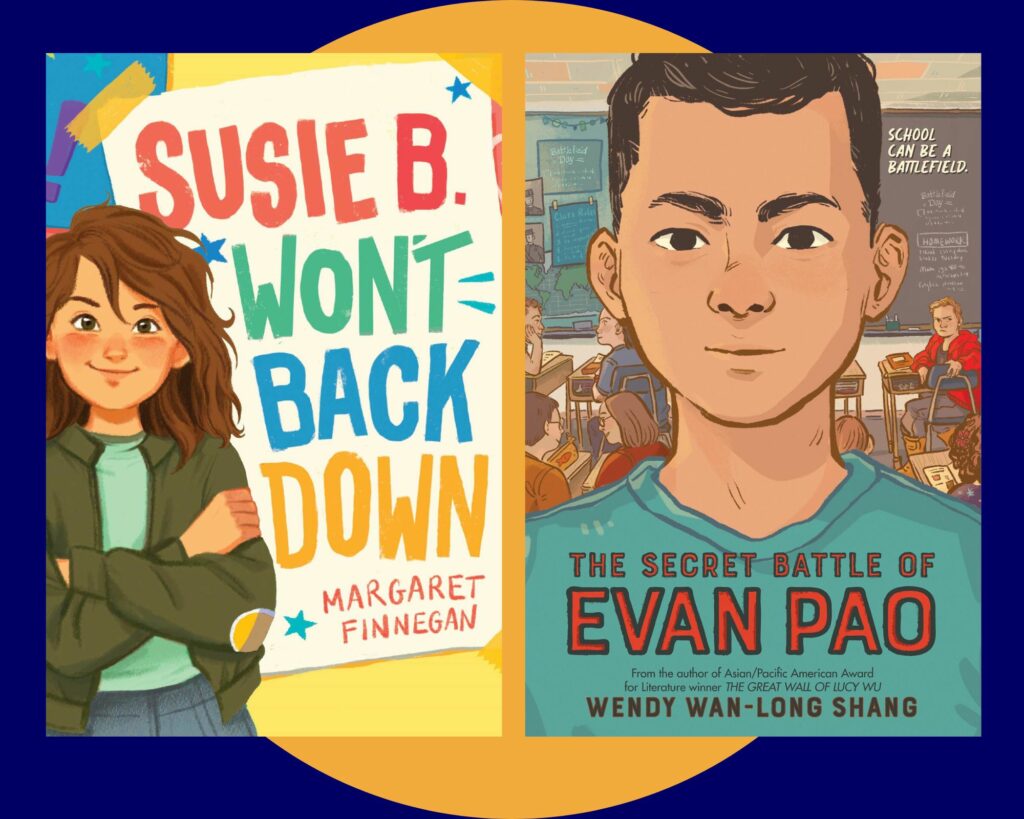
Cindy’s Picks
I have two new middle grade chapter books that I am very excited to recommend this month!
“Dear Susan B. Anthony:
I have very bad news for you. You’re dead. Really dead. Like, over one hundred years dead. Like, right now, you are dust and bones in the cemetery of your old hometown, Rochester, New York.
Sorry.
You are probably thinking, what the heck? If I am dead, why are you writing to me?”
In Susie B. Won’t Back Down by Margaret Finnegan, Susie B’s personal hero is Susan B. Anthony. Susie B. is also running for student council president, and she thinks that she has the race in the bag when an amazing new candidate enters the race. At the same she discovers her hero might not have been as great as some versions of history suggested she was—and Susie B. realizes she has some very tough decisions to make.
The second book is called The Secret Battle of Evan Pao by Wendy Wan-Long Shang. Evan Pao is hoping for a fresh start when he and his mother and sister move from California to Haddington, Virginia. They are hoping to keep the secret of his father’s notoriety.
In the small Southern town, Evan makes a lot of friends, but he is also bullied at Battlefield Elementary by another student because he is Chinese American—one boy, Brady Griggs, is determined to make Evan’s life miserable. Evan also finds a unique way to make himself a part of the school’s annual Civil War celebration, but it backfires terribly. How will Evan figure out how he fits into his country’s past and how will he help shape its future? Read this book to find out!
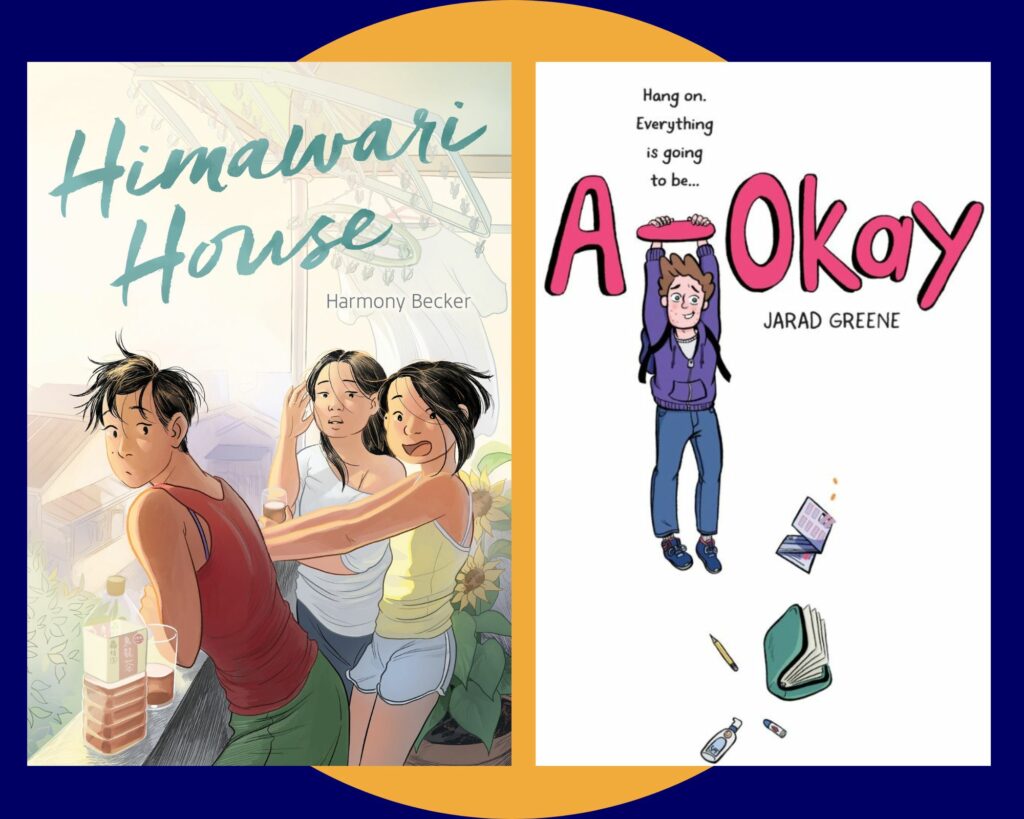
Carly’s Picks
This month, I’m excited to recommend three great graphic novels from the Teen Library.
In Harmony Becker’s Himawari House, main character Nao was born in Japan but grew up in the United States. Perceived as “different” and “other,” she forgoes her first language and Japanese cultural traditions in an effort to fit in. By age eighteen, though, Nao misses these parts of herself—so she decides to return to Japan, the place she considers her true home, for a gap year after high school. The story that follows is a thoughtful, beautifully rendered exploration of cultural identity, friendship, family and found family, and growing up.
In A-Okay by Jarad Greene, eighth grade brings a lot of changes for Jay: shifting friend groups, questions about his self-identity, and a case of acne that only responds to a harsh medication. Readers follow Jay throughout both the school year and the course of his acne treatment (and its accompanying side effects). In the Teen Library, we’ve seen that comics and graphic novels like A-Okay can be an approachable way for young and grown readers alike to understand complex health topics. Check out our Teen list, Graphic Medicine, if you’re looking for more stories where health and art intersect.
Finally, the graphic memoir, Victory. Stand!, celebrates the life of Olympic gold medalist Tommie Smith. Readers learn about his rise to become a world-class runner alongside the emergence of his identity as an activist for racial justice, which culminated on the Olympic podium in 1968. After receiving gold and bronze medals respectively, Smith and teammate John Carlos raised their fists in a Black power salute to protest the treatment of Black people in the United States. Their action was met with outrage from the Olympic committee and anger from white Americans and journalists who felt the protest was distasteful. Yet time has only increased the widespread recognition of Smith and Carlos’ bravery. Smith’s story—co-written by Derrick Barnes and illustrated by Dawud Anyabwile—is a timely reminder of the longstanding tradition that ties athletics with activism.
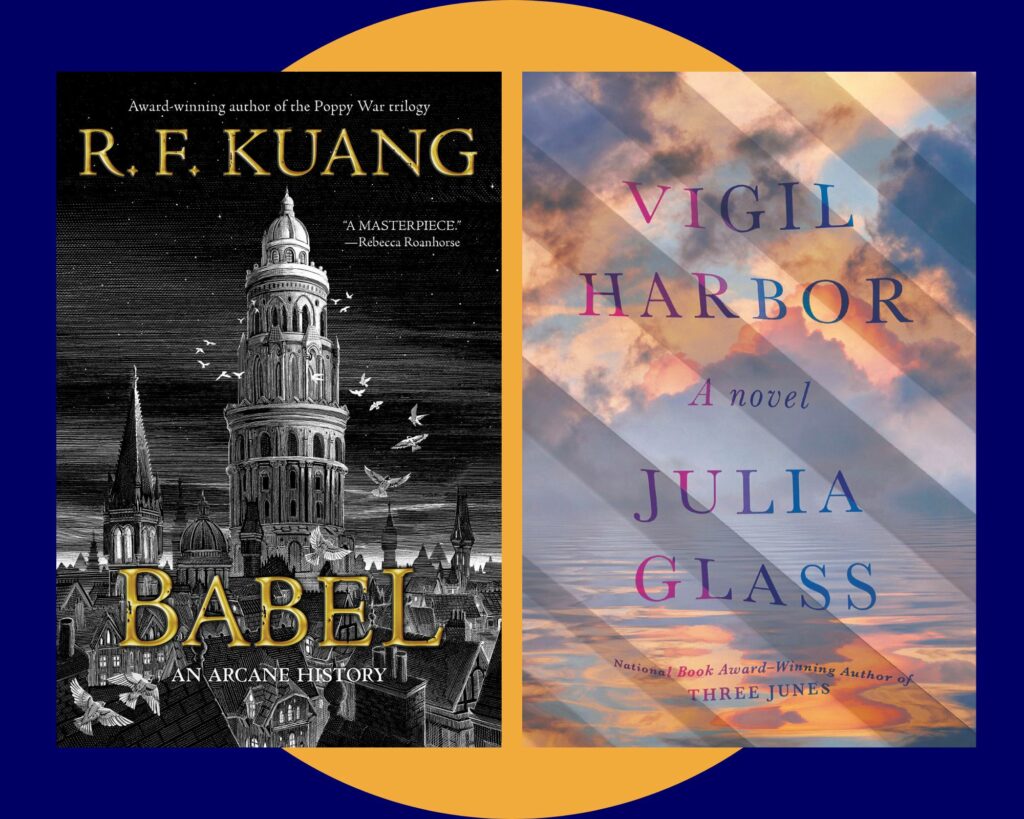
Becca’s Pick
Babel: An Arcane History might just be my favorite book published in 2022. It’s the late 19th century in Oxford, and a diverse group of students begin their studies at the Royal Institute for Translation. In the giant tower known as Babel, they will learn the art of silver working, or finding “match pairs” of words in different languages that activate the silver in ways that drive industrial growth. When some of the students are invited to join a separatist group of translators working against Babel, they must decide if their loyalties lie with the British Empire or their countries of origin.
There is so much packed into Babel‘s 500 pages. We’ve got issues of race, class, imperialism, and protest. It invites more than one moral quandary and does not offer easy answers. It also contains stunning fantasy elements and a chaste queer love story! This is dark academia at its finest, and I found myself regularly staying up way past my bedtime to read 40-50 pages at a time. If you’re a fan of student stories like The Secret History, descriptive magic like Jonathan Strange & Mr. Norrell, or the alchemic fantasy of The City of Brass, then this book is for you.
Stephanie’s Pick
Vigil Harbor by Julia Glass is terrific and scary in a very real way. It’s not a traditional mystery, but I couldn’t put it down. It is set mostly in a very believable future, maybe 10 years from now, in a wealthy liberal coastal village like Marblehead. Perfectly drawn characters deal with climate change, political violence, new disease, lost love and the mysteries of the sea. I found it compelling enough to merit an award, but I’m not on any committees. I figure you can’t ask for more than a dramatic plot with real characters (well, mostly real), who make you think about that heavy list above. I loved it and actually worried about these people and us.
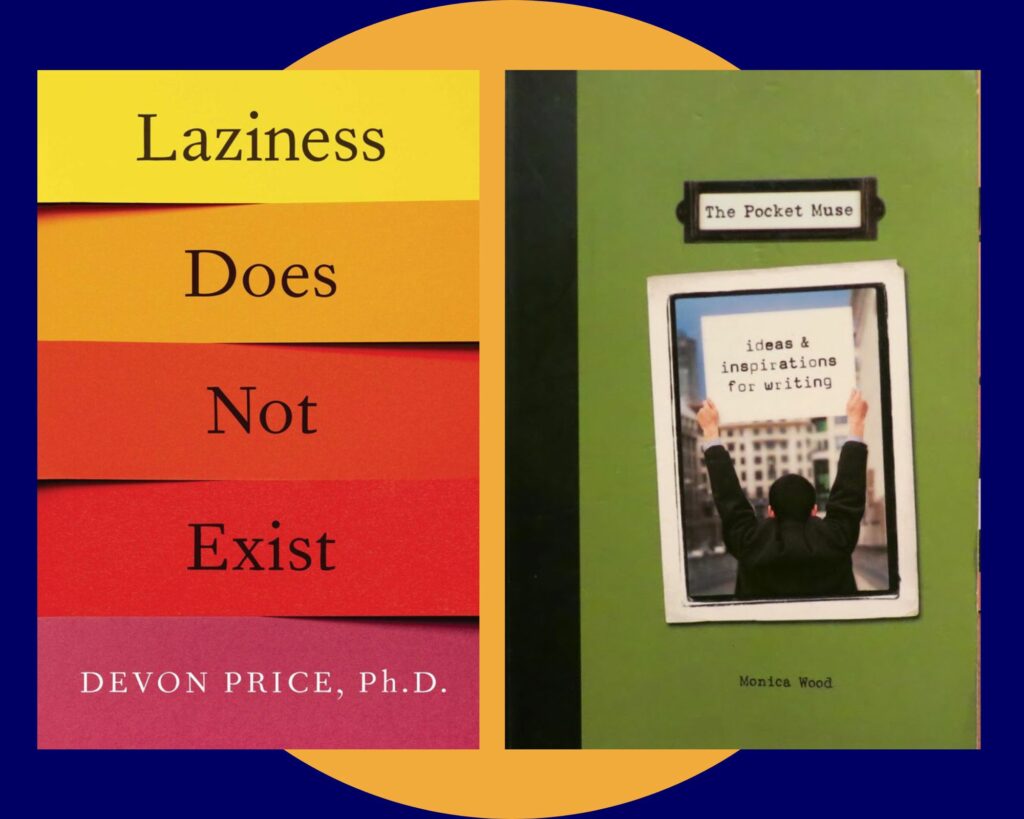
Marie’s Pick
Please read Laziness Does Not Exist by social psychologist Dr. Devon Price. It is a thoughtful, accessible takedown of capitalism’s demand for constant productivity; a plea to slow down for the sake of our humanity. Another world is possible, wherein doing “nothing”—resting, playing, loving, daydreaming, being—is the most valuable thing we can do.
Abraham’s Picks
“An observing spirit can thus derive pleasure from the most trivial circumstance.” —Thomas Cogan, from Treatise on the Passions and Affections of the Mind (1813)
The Autumn season—still temperate enough for extended walks, hikes, and enjoyment outdoors—inspires creative musing and expression. Whether you’re in the city, by the ocean, or in the woods, there can be opportunities to observe and appreciate the light and colors of the season. In his journals, Henry David Thoreau wrote in detail about how he saw autumn and what his observations brought to mind. Here are a few books to help supply journal-writing ideas, with prompts and anecdotes: The Pocket Muse (by Maine’s own Monica Wood!), Creative Journal Writing, Keeping a Nature Journal, and The Journal – Henry David Thoreau.
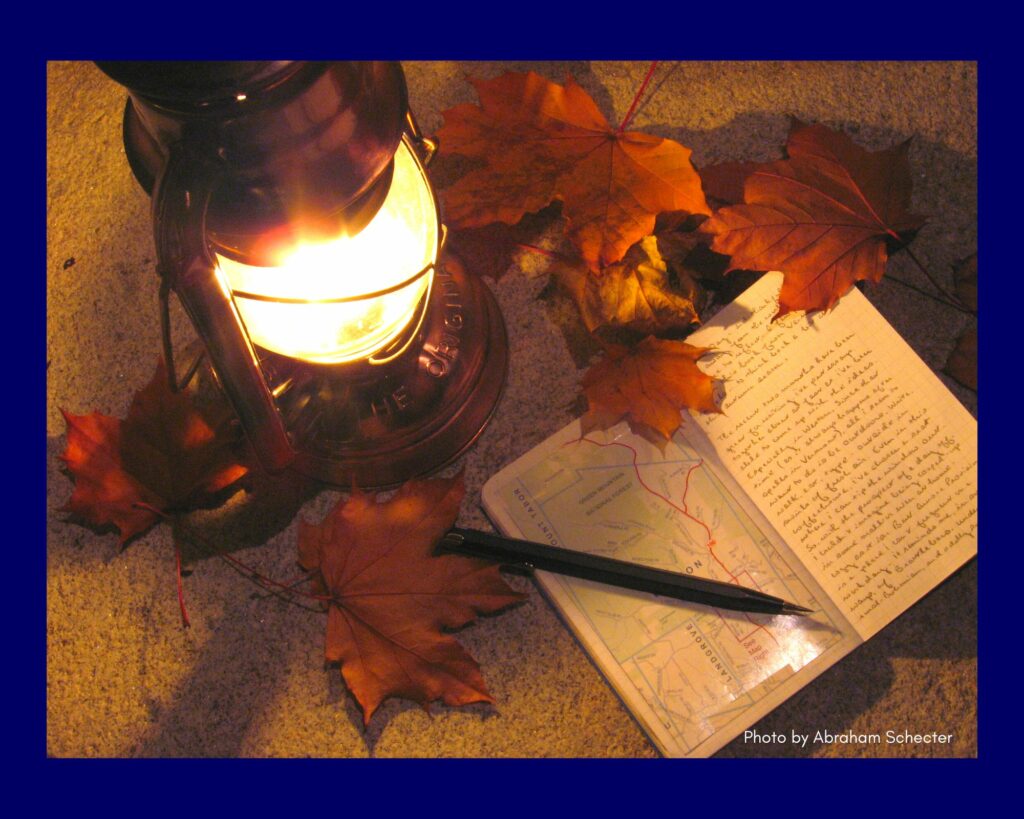
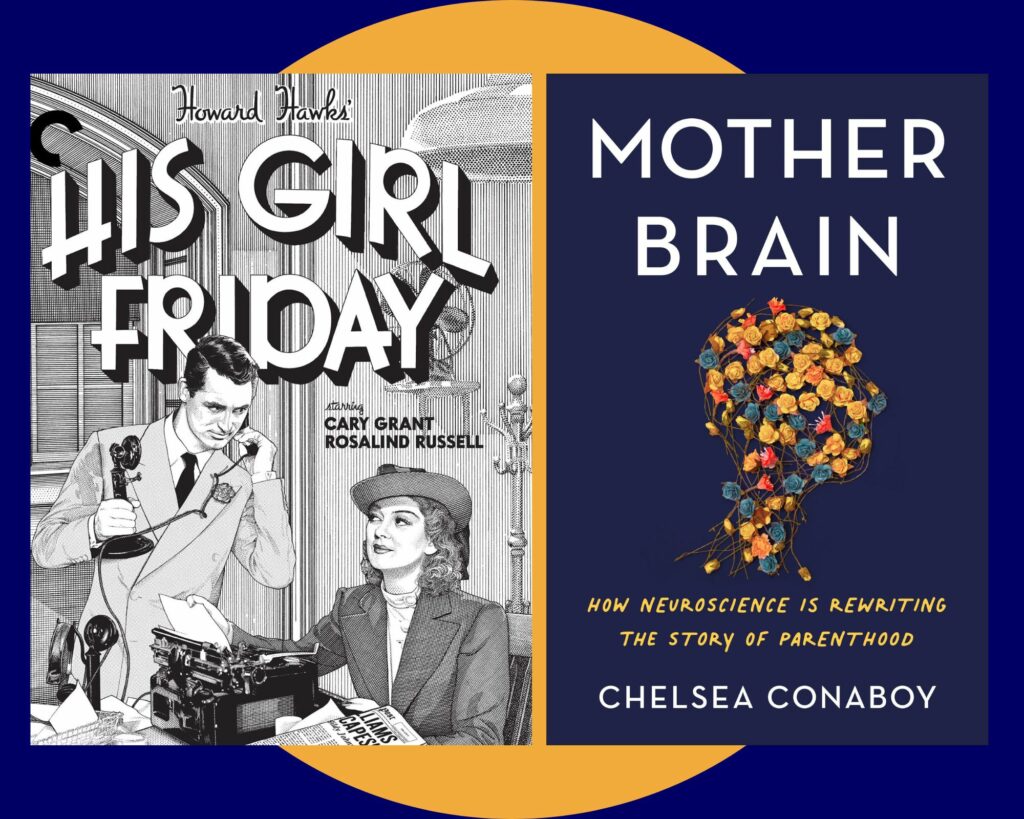
Eileen’s Pick
The sky, on my early morning commute today, was soft black. At one magical moment, a small but mighty white light streaked across it. Left to right, east to west, it fell in an arc, at a precise trajectory to be swallowed by the treetops.
I think of November as the black-and-white month. Mostly, the palette falls between the two, but I will refrain from saying that it is shades of gray, of any quantity. Our bird neighbors are chickadees, nuthatches, titmice, woodpeckers, matching the landscape and the light. Stark and beautiful, trees’ silhouettes counter each other, birch against hemlock against oak against pine against birch and on and on. Color leaks from familiar shapes and granite soaks it up to be released next year in a springtime frenzy. For now, though, black and white not only suffices, but fulfills. That is the time we are in and it is soulful and satisfying and an opportunity to appreciate subtle contrasts and myriad tones and shades. Black and white can be many hued, startling or calming.
Or just entertaining. And this is where I finally, finally…good gravy, you thought I’d never get to my staff pick, didn’t you?…make a case for my November Pick. How about a really good black-and-white movie to cheer you through a dark couple of hours? Something visually neutral, yes, but supersonically fast-paced to prevent dozing off with a tell-tale trail of drool working its way floorward. Hollywood studio written all over it? You bet. Hollywood, in a good way, that is.
Friends, I nominate His Girl Friday as an exceptionally satisfying diversion from anything you need to be diverted from. Land yourself with Cary Grant and Rosalind Russell for this 1940 Howard Hawks directed re-do of the “The Front Page” by Charles MacArthur and Ben Hecht. Russell is outstanding, as is Grant. I challenge you to keep up with the rapid-fire repartee… if you can follow closed-captioning at speed, you may actually catch it all. Maybe. But don’t count on it.
For me, black and white doesn’t get better than this. November is a perfect time for it, and for that and so much more, I give thanks.
Rachael’s Pick
I read Mother Brain by local writer Chelsea Connaboy last month and really enjoyed it. After bearing witness to my own brain changing through pregnancy and raising children it was fascinating to make connections between what happened and why it was happening.
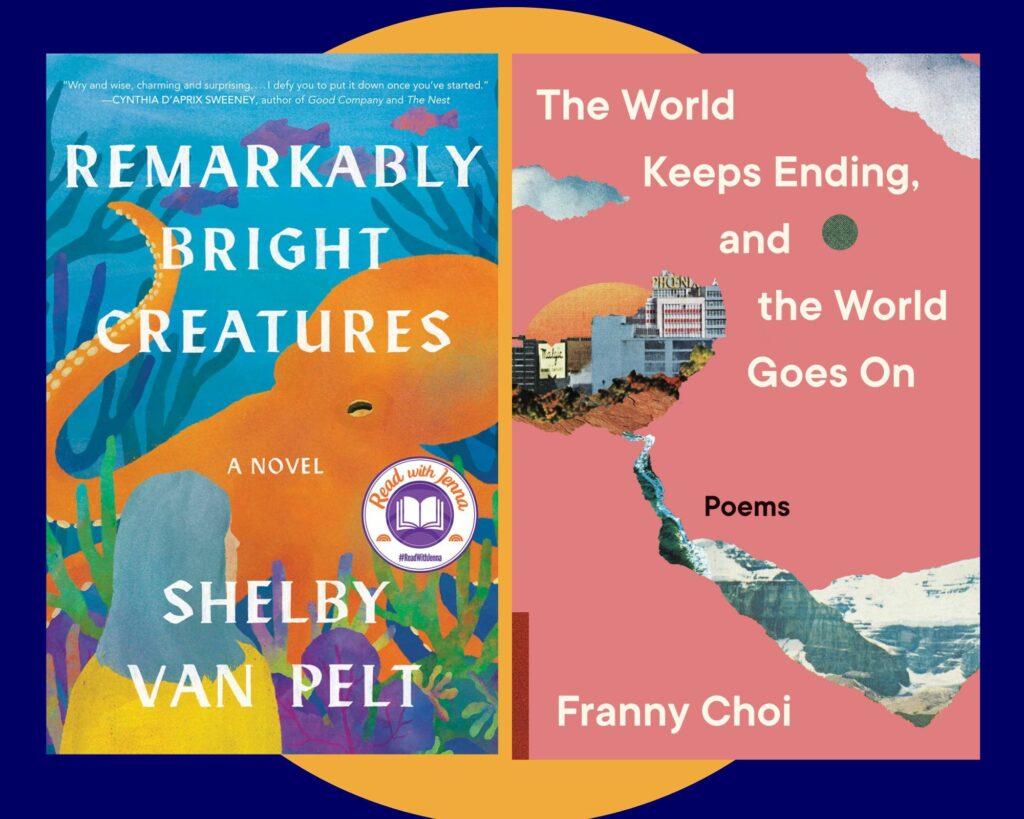
Jim’s Picks
A month for octopuses! I read two fiction books on the theme of super-intelligent octopuses: The Mountain in the Sea by Ray Nayler and Remarkably Bright Creatures by Shelby Van Pelt. If you eat seafood, you may alter your habits after reading.
Elizabeth’s Picks
As the days get colder and the nights close around us, my stacks of books begin to teeter ever higher.
“I love the dark hours of my being / for they deepen my senses.” Pádraig Ó Tuama quotes Rilke in Poetry Unbound: 50 Poems to Open Your World. I’ve followed Pádraig Ó Tuama’s gentle, insightful discussions of poetry on the podcast Poetry Unbound since I saw him read in a program with Portland Poet Laureate Maya Williams last year. Here he wings through and responds to the work of contemporary favorites—Kaveh Akbar and Aracelis Girmay, Hanif Abdurraqib and Ilya Kaminsky, as well as poets who are new to me— like Gregory Pardlo, Joy Ladin, and Paul Tran, who writes “There’s a dark so deep beneath the sea the creatures beget their own / light.” These poems resonate through all the hours after sunset.
An Irish novella: Claire Keegan’s writing is luminous as ever. Foster is a quiet, tender tale that haunts in all it says and does not say.
More poetry! It feels like I’ve been waiting a long time for Franny Choi’s The World Keeps Ending, and the World Goes On. It’s here, along with the immediacy and clarity of her voice: “Like everyone else, I want a storm I can dance in. / I want an excuse to change my life.”
Making Love With the Land by Joshua Whitehead (a Two-Spirit, Oji-nêhiyaw member of Peguis First Nation) has also arrived in time for winter: “I remember us this way, two Prairie queers celebrating the generosity of an accepting land and a blanket of family.”
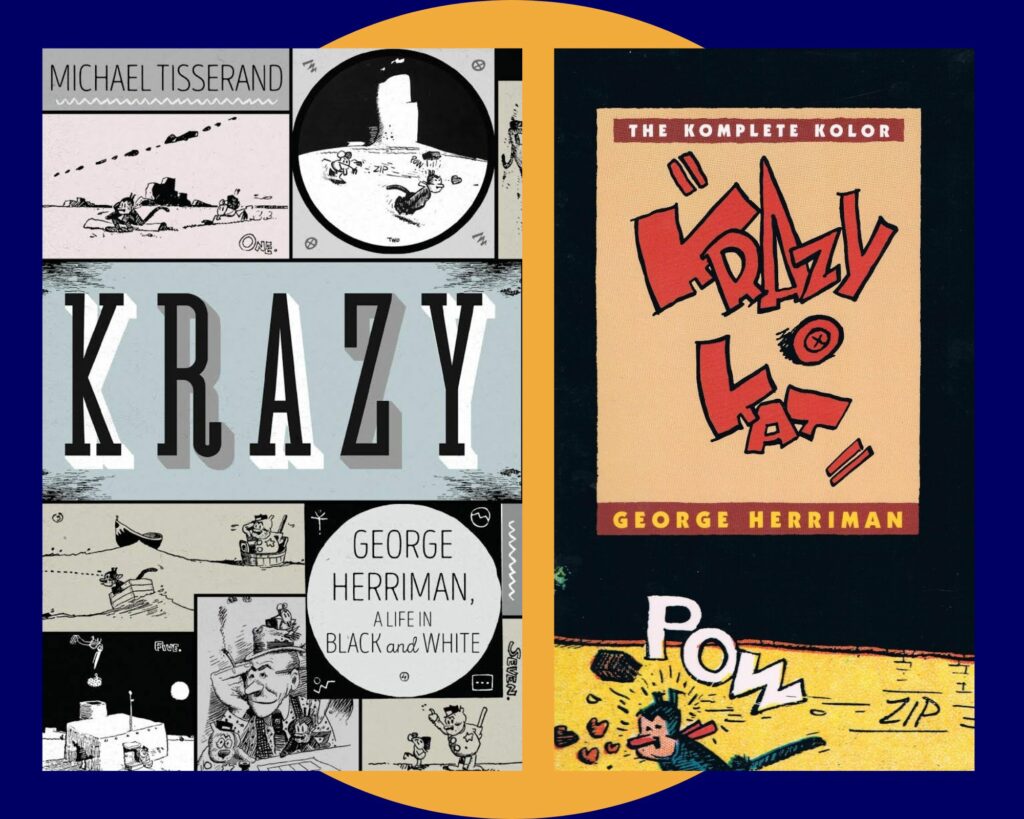
Aaron’s Picks
Cartoonist George Herriman, creator of the genre-defining-and-defying Krazy Kat comics that ran in American newspapers from 1913 to 1944, lived a life nearly as unlikely as the absurd, missed-connection adventures of Krazy and their pals’ lives in the vividly-drawn Southwest desert locale where the strip takes place. [Note that throughout his life Herriman declined to define Krazy Kat as either male nor female, and often used they/them pronouns to describe them.] The blockbuster revelation that opens Michael Tisserand’s biography of Herriman—a fact widely acknowledged only after his death—is that Herriman was a Black man who spent the latter part of his childhood and his entire adult life “passing” as white. This in itself doesn’t make Herriman unique. Passing was common in the 19th and early 20th century and motivations for doing so quite plain. But the particular route Herriman travelled from the relatively affluent Creole community of post-Civil War New Orleans to turn-of-the-century and early-mid-century New York, Los Angeles, and Arizona offers further complexity to narratives of race and community across eras and a continent.
Tisserand tells the complex story with sensitivity. Where certain parts of the book may get bogged down in a sequential listing of the known events of Herriman’s life, there is always reference to the evolution of Herriman’s style and craft, to notable strips or panels he drew, and a wealth of background on the development of American cartooning and newspaper comic strips.
The comic strips themselves, and especially the fully realized full-page, full-color Krazy Kat strips as seen in The Komplete Kolor Krazy Kat, are often referenced by later cartoonists including Charles Schultz, Will Eisner, and Bill Watterson (who wrote the anthology’s foreword) as an inspiration and as an origin point of many innovations in comic art.
Not just a predecessor or step on the way to modern cartoons, though, Krazy Kat is closer to its own genre, an absurd, slapstick, tragicomic, existential roller coaster often more reminiscent of Samuel Beckett than Fontaine Fox (Toonerville Trolley) or even Watterson and other more recent artists. Herriman’s visual style is stunning, the Arizona desert rendered in stark colors and shapes bordering on abstract art. Krazy Kat, Ignatz Mice, and the rest of the regular and irregular characters are as dynamic in their motion and action as Looney Tunes, but without feeling polished or sanitized at all. The visual and spoken language of Herriman’s characters is an unexpected combination of patois and pidgin English, Shakespeare and other literary riffs, references to Greek philosophy and European and American art, subtle (and not-so-subtle) nods to race and racism, all clearly born of an intensely personal landscape of humor and aesthetics.
That Krazy Kat ran in major newspapers at all perhaps speaks to a past with a wider-open field for all kinds of art and writing, a world with a growing, or at least thriving, print culture compared to today’s shrinking major print media. Regardless of whether today’s newspaper cartoonists list him as an inspiration, the places where Herriman’s spirit truly lives on today are mostly in the underground and independent comic and zine communities. Whatever their other qualities, there’s little chance of running into something as beautiful—or as funny—in the pages of the Portland Press-Herald or the Bangor Daily News today. Lucky for us, a great number of Herriman’s strips survive and have been collected in published volumes, and a biography suitable to the subject has been written.
Thanks for reading! To check out a full catalog list of all the titles we mention here, see: Long Nights, Bright Books: Our Staff Picks.
If you’re looking for more reading ideas, that is our very favorite thing! Check out our Your Next Great Read service for readers of all ages, or simply reach out to our staff at readersadvisory@portlib.org for your own personalized booklist of reading suggestions.

























